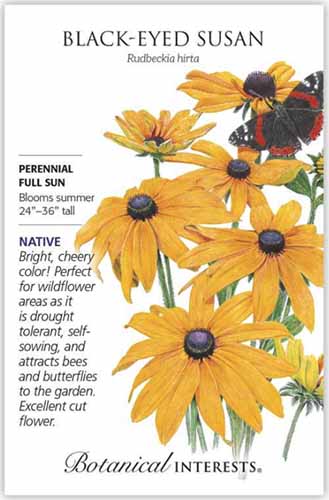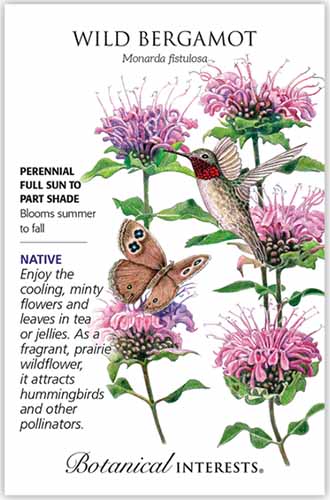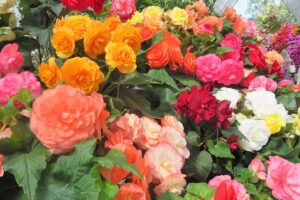If you’re hoping to create a more sustainable yard or garden, using native plants in the landscape is a no-brainer: these locally adapted species are beautiful, low maintenance, and waterwise.
And some native wildflowers are wide-ranging and highly adaptable, making them even easier for more gardeners to grow!
I’ve narrowed down a list of 15 species of native wildflowers that are widespread across the continental United States and Canada.
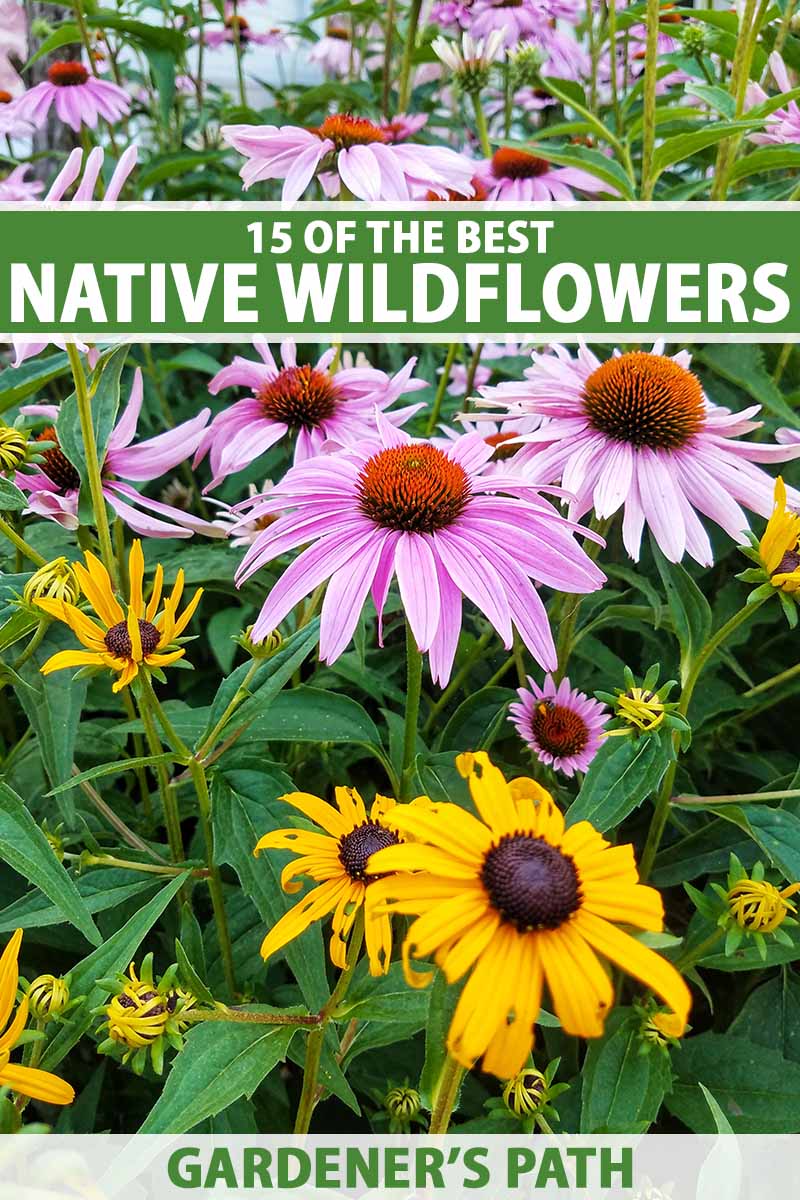
We link to vendors to help you find relevant products. If you buy from one of our links, we may earn a commission.
And with a wide range, that means these plants tend to adapt well to different conditions.
For each of these wildflowers, I’m going to let you know what the foliage and flowers look like, and I’ll share info about about bloom time and height as well.
I’ll also include the details on each species’ native range along with its preferred sunlight, soil, and water requirements, so you can choose the best options for your particular landscape.
And in case you need ideas on how to use these beauties, I’ll offer some landscaping ideas – as well as some tips on where to obtain seeds.
Ready to learn about these lovely locals? Here’s a sneak peek:
15 of the Best Native Plants for the US and Canada
Note that all growing zones mentioned below were derived from the USDA Hardiness Zone map of planting regions.
1. Black-Eyed Susan
Black-eyed Susan makes a cheery appearance in the garden with its large, daisy-like yellow flowers with brown centers.
Known as Rudbeckia hirta among botanists and the scientifically minded, in the wild this plant grows in prairies, and is native to the eastern two-thirds of North America.
A member of the Asteraceae family, black-eyed Susan is a short-lived perennial that’s hardy in Zones 3 through 7, but it is also sometimes treated as an annual.
This wildflower blooms from summer until first frost.

Black-eyed Susan requires full sun and moderate water. With good drought tolerance, it is adaptable to soils that are dry to moist, as long as the soil is well-drained.
For more tips, be sure to read our complete guide to growing black-eyed Susans.
This species grows to be two to three feet tall and one to two feet wide, and it is not particularly attractive to deer.
For those looking for juglone-tolerant plants to include near black walnut trees, you can add black-eyed Susan to your list!
In the landscape, you might consider using black-eyed Susan in a variety of ways – it looks great in a flower bed or border, and is particularly showy when used in mass plantings.
New England aster, butterflyweed, and purple coneflower (selections we’ll be discussing a bit later) all make excellent companions for this species, both in terms of cultural requirements, and in terms of aesthetic appeal.
One of the advantages of gardening with natives is the opportunity to observe unique interactions between local plants and local pollinators. These relationships are to be both expected, and celebrated!
As for black-eyed Susan, it serves as a larval host for bordered patch butterflies (Chlosyne lacinia) and gorgone checkerspot butterflies (Chlosyne gorgone).
You can purchase black-eyed Susan seeds in 500 milligram packets from Botanical Interests.
2. Blue Vervain
Our next selection may be a bit less familiar to some gardeners than the black-eyed Susan, however, blue vervain has a wide native distribution, and is found growing wild in almost all US states and Canadian provinces.
Hardy in Zones 3 to 8, blue vervain has green leaves that are lance-shaped with deeply serrated margins.
Verbena hastata is also called “American blue vervain,” “swamp verbena,” “blue verbena,” and “simpler’s joy.”
A member of the verbena family, blue vervain has long spikes of purplish-blue flowers that bloom from midsummer to early fall.

Blue vervain has a spread of twelve to thirty inches, and usually grows to be two to four feet tall, sometimes reaching six feet tall.
In the wild, this plant grows in moist locations, where it is highly adaptable to different amounts of light. This species can grow in full sun, part shade, or full shade.
However, its moisture requirements are not as flexible. It should be grown in soil that is moist or wet, and makes a great selection for a rain garden.
Blue vervain can self-seed when grown in the right conditions, so pick off spent flowers if you want to prevent spread.
Alternatively, you might locate it where its spread would be appreciated, such as in a naturalized-type garden.
Joe-pye weed, common self-heal, and cardinal flower make ideal companions.

You’ll find blue vervain seeds in a choice of package sizes from Everwilde Farms via Amazon.
Find tips on growing joe-pye weed here.
3. Butterflyweed
A type of milkweed, butterflyweed has deep orange flower clusters held aloft above dark green foliage.
In Canada, this plant is native to Ontario and Newfoundland, while in the US its native range stretches from New England to Florida, and west to Colorado and Texas.
Asclepias tuberosa is hardy in Zones 3 to 9, and blooms from May through September.
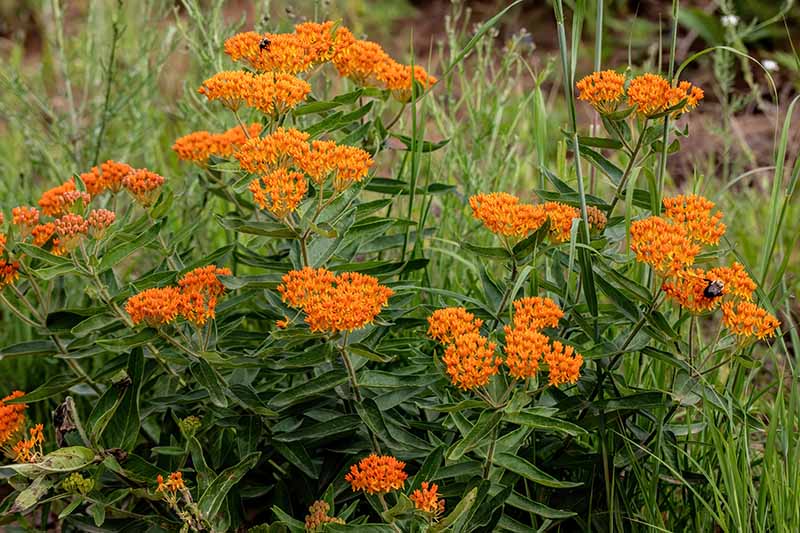
This species can thrive in full sun or part shade. Its water needs are low once established, and it is quite drought tolerant.
Reaching heights of one to three feet, butterflyweed is adaptable to many different soil types as long as it has good drainage. For further guidance, make sure to read our complete guide to growing milkweed.
Fitting companions for butterflyweed include purple coneflower, gray goldenrod, common yarrow, wild bergamot, nodding onion, and black-eyed Susan.
In fact, a design that includes all six of these species would look absolutely beautiful!
You’ll find both conventionally and organically grown butterflyweed seeds available for purchase in packs of 150 milligrams at Botanical Interests.
If this variety of milkweed isn’t native to your particular region, have a look at our guide to 15 of the best types of milkweed for monarchs to identify the species that are best suited to your area.
4. Cardinal Flower
A type of lobelia, cardinal flower is a native plant that produces spikes of bright red flowers. These red inflorescences are held above dark green leaves that are lance-shaped with finely serrated margins.
This plant has a very wide native distribution, ranging from southern Canada all the way south to northern Colombia in South America.
In the US its native range stretches from Maine south to Florida, with its western range spanning to Minnesota, Nebraska, and Colorado, and across the southwest to California.
Lobelia cardinalis starts producing its showy red blooms in late summer, making it one of the best perennials to grow for fall color.

This member of the bellflower family is hardy in Zones 3 to 9, and reaches two to three feet tall, or sometimes up to four feet.
Cardinal flower thrives in full sun or part shade, with afternoon shade appreciated in hotter climates.
This species thrives in moist to wet soils, and since it tolerates brief flooding, it can be used in rain gardens.
Growing best in soils with plenty of organic matter, cardinal flower shows moderate deer resistance.
And although it may not attract deer, it does attract hummingbirds! The long, red, tubular flowers of this species make it a great choice for a hummingbird garden.
Blue vervain, fall sneezeweed, or common self-heal will make good companions.

Want to add this hummingbird favorite to your garden? You’ll find seeds in an assortment of packet sizes from Everwilde Farms via Amazon.
Read more about growing cardinal flowers here.
5. Common Self-Heal
Common self-heal is easily recognizable as a member of the mint family.
As do many of the members of this family, common self-heal has spikes of blueish purple flowers, square stems, and leaves arranged on the stems in opposite pairs.
However, this species lacks the fragrant flowers and foliage that its numerous mint relatives are known for.
Also known as “lance self-heal” and “heal all,” this plant has an extremely wide native distribution, growing wild across North America, and also throughout Europe and most of Asia.
Prunella vulgaris blooms from midsummer until fall, and though its flowers are usually blue or purple, they are sometimes seen in pink or white.

Common self-heal grows to be twelve inches tall and eight inches wide, and is hardy in Zones 4 to 8.
Adapted to both full sun and part shade, it does best with afternoon shade in hotter climates. It will thrive in different soil types but prefers moist conditions.
An edible plant, as its common names suggest, common self-heal is often used medicinally.
But humans aren’t the only ones who appreciate it – this species is also a larval host for the clouded sulphur butterfly (Colias philodice).
Like many members of the mint family, common self-heal makes an excellent groundcover.
Its low stature means it can be placed at the front of a bed with some taller companions behind it. Cardinal flower, blue vervain, and fall sneezeweed make good moisture-loving companions for this species.
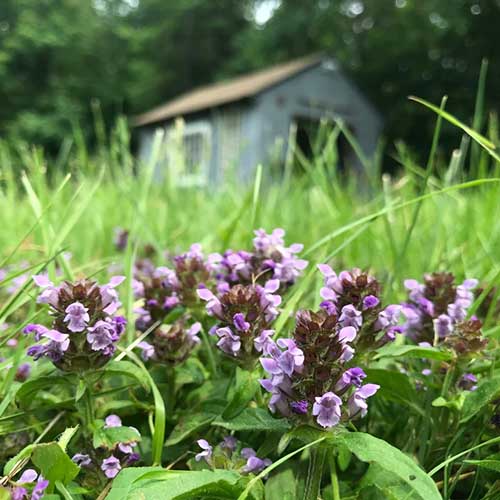
You can purchase packs of 50 seeds of common self-heal from Earthbeat Seeds.
6. Common Yarrow
Another member of the aster family, common yarrow is widespread not only across North America, but throughout the northern hemisphere.
With delicate fern-like leaves, and umbels of flowers that are usually white, Achillea millefolium flowers from spring in southern locations to fall in more northern areas. Flower clusters are also sometimes pink.
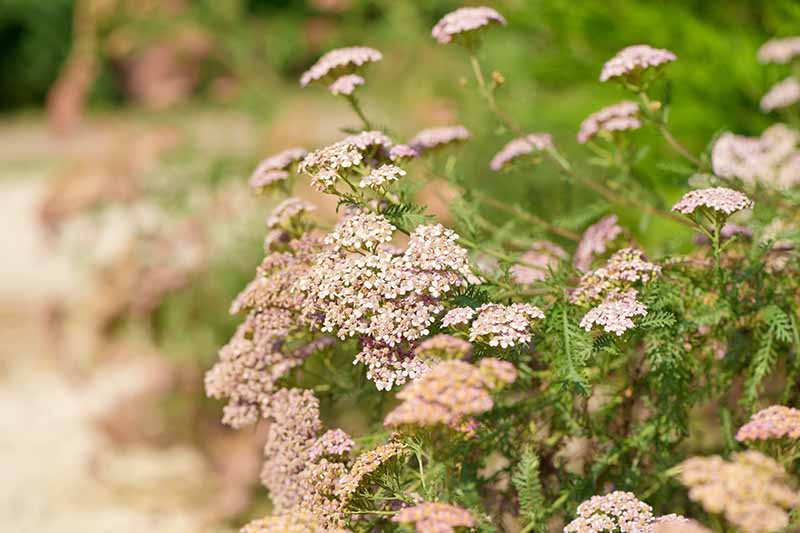
Common yarrow reaches two to three feet in height with a spread of two to three feet.
Drought tolerant, it grows best in full sun and can thrive in dry to moderately moist conditions.
Common yarrow does best in sandy loam soils and requires good drainage. If grown in rich, overly moist soils, plants can flop over. You can find more tips on growing yarrow in our guide.
Like common self-heal, which was mentioned above, common yarrow is widely used as a medicinal plant.
The striking umbel-shaped flowerheads of this plant provide structural interest in a mixed bed planting. Common yarrow also looks striking in mass plantings.
Good garden companions include purple coneflower, gray goldenrod, butterflyweed, wild bergamot, and black-eyed Susan.
Ready to plant yarrow from seed? You’ll find 50 milligram packs of Colorado blend, a selection with pink, red, yellow, and white flowers, at Botanical Interests.
7. Fall Sneezeweed
Don’t expect this plant to make you sneeze – its odd common name comes from the plant’s historical use as snuff.
Fall sneezeweed is native to most of the US and Canada, except for New England, where it has naturalized.
Helenium autumnale is a perennial that has dark green foliage. Flowers have wedge-shaped, yellow petals with greenish yellow centers.
An excellent choice for late summer blooms, fall sneezeweed is in flower from late summer through fall.

A member of the aster family, this species requires full sun and moist soil, preferably clay.
Fall sneezeweed reaches three to five feet tall, has a spread of two to three feet, and is deer resistant.
It’s a great wildflower to include in your cut flower garden. Cardinal flower or common self-heal will make good companions.

You can find fall sneezeweed seeds in a selection of package sizes from Everwilde Farms via Amazon.
8. Fireweed
After wildfires wreak havoc, fireweed is one of the first species to recolonize the burnt landscape, spreading swaths of bright magenta flowers across the land.
Fireweed has an extremely wide distribution throughout the Northern Hemisphere, including most of North America, Europe, and Asia.
In the US, it grows in Alaska, throughout the western states, in the Midwest, and from Tennessee and North Carolina north to Maine. It’s also native to every province in Canada. This perennial is hardy in Zones 2 to 7.
Classified taxonomically as Chamerion angustifolium, fireweed is also known as “fire weed” (written as two words,) “narrow leaf fireweed,” and “blooming sally.” It was previously classified as Epilobium angustifolium.
Fireweed’s long, narrow leaves look like those of willows, inspiring a couple of other common names: “willow herb” and “great willow herb.”
A member of the Onagraceae family like its relative evening primrose, fireweed’s upright racemes of magenta flowers bloom from summer to fall.

Though fireweed usually grows to heights of two to six feet, occasionally it reaches an outstanding nine feet tall. It typically has a spread one to three feet.
This species grows well in full sun, but in climates with hot summers, it is happier in part shade.
Fireweed is adaptable to different levels of moisture availability, from medium-dry to medium-wet. It grows best in acidic soils that are rich in organic matter and well-drained, with a pH between 5.0 and 6.6.
C. angustifolium spreads via rhizomes and self-seeding, so this plant works best in a naturalized-type planting.
It is also suitable for rock gardens, borders, and cottage gardens, and is very striking when grown in large swaths, for more color impact.
This species is not very aggressive about keeping its place in a mixed bed. In the wild, it’s usually found growing with native grasses and sedges, so you might take a cue from nature and create a similar combination.
Fireweed is a larval host to the white-lined sphinx moth (Hyles lineata), and also attracts long-tongued bees and hummingbirds.

You’ll find fireweed in jumbo packets of 1,250 seeds from Everwilde Farms via Amazon.
9. Gray Goldenrod
With its large sprays of golden flowers, gray goldenrod creates a mass of bright color from summer to fall.
Native to the eastern two-thirds of North America, Solidago nemoralis is hardy in Zones 3 to 9.
A member of the sunflower family, gray goldenrod has grayish-green foliage, and its spikes of yellow flowers nod slightly when in full bloom.

Also called “prairie goldenrod,” “old field goldenrod,” or “field goldenrod,” this perennial grows to be six to 24 inches tall with a six- to 24-inch spread. It’s one of the smaller goldenrods.
Gray goldenrod can grow in full sun or part shade, tolerates dry or medium-dry conditions, and thrives in poor soil. It’s ideal for planting in sandy, rocky locations.
This species spreads by rhizomes and self-seeding, so it is best used in naturalized plantings, such as in cottage gardens.
Butterflyweed, black-eyed Susan, common yarrow, Jerusalem artichoke, nodding onion, and wild bergamot make excellent companions for gray goldenrod.

Find gray goldenrod in packs of 2,000 seeds from Everwilde Farms via Amazon.
Learn about growing goldenrod here.
10. Jerusalem Artichoke
Related to sunflowers, the Jerusalem artichoke is known for its edible tuber, which has a taste reminiscent of globe artichoke.
This species is native to eastern and central North America, the Intermountain West, Idaho, and Washington. It is hardy in Zones 3 to 9.
Also called sunchoke, the flowers of Helianthus tuberosus have yellow petals and greenish-yellow centers, with green foliage that is rough to the touch.

This wildflower grows to be six to 10 feet tall with a spread of three to five feet, and it blooms in late summer.
Jerusalem artichokes are adaptable to either full sun or part shade, and either dry or moderately moist soils.
A somewhat drought tolerant plant, Jerusalem artichokes are adaptable to different soil types, provided the soil drains well. You can read more about growing and caring for Jerusalem artichokes in our guide.
This species spreads through rhizomes and self-seeding, so it is best used in a natural-type planting where its spread will be appreciated rather than regretted.
Purple coneflower, wild bergamot, nodding onion, and New England aster will make good companions.

Organic Jerusalem Artichoke Tubers
Ready to plant these perennials? You can purchase Jerusalem artichokes tubers from Yumheart Gardens via Amazon.
11. Joe-Pye Weed
With flat clusters of fragrant pink or purple flowers, Joe-pye weed is a pollinator favorite.
This plant is native to most of the northern two-thirds of North America, and is hardy in Zones 4 to 8.
A member of the composite family, Eutrochium maculatum, the variety that I am recommending here is a perennial species that was formerly classified as Eupatorium purpureum.
There are several more closely related species that also go by this common name, and all have similar growing requirements. You can read more about them in our guide.
Its leaves are oval-shaped with serrated margins on stems that have purplish spots, giving this species another of its common names, “spotted joe-pye weed.”
Joe-pye weed’s pink or purple flower clusters bloom from late summer to autumn, and look most dramatic when used in mass plantings.

Joe-pye weed grows four to seven feet tall with a spread of three to four feet.
It can grow in full sun or light shade, and prefers rich soils rich with plenty of organic matter. Adaptable to moderate or wet conditions, it makes a good member of a rain garden.
Combine joe-pye weed with New England asters, fall sneezeweed, common self-heal, or blue vervain.

Joe-pye weed seeds are available in an array of packet sizes from Everwilde Farms via Amazon.
12. New England Aster
Looking for a native substitute or companion for fall blooming chrysanthemums? Why not give New England aster a try?
Despite its common name, this species has a range well beyond New England.
It’s native to most of the eastern half of Canada, and a large swath of the US, ranging from New England south to Georgia, and west to Oklahoma, New Mexico, Utah, Wyoming, and Montana, as well as the Pacific Northwest.
New England aster (Symphyotrichum novae-angliae) has stout stems and dense foliage, with leaves that clasp its stems.
Blooming from late summer until frost, the flowers have orange centers. The petals are usually lavender, but can also be blue or white.

This plant grows to be three to six feet tall and two to three feet wide.
It requires full sun and prefers rich, moderately moist to moist soils with good drainage. To learn more, be sure to read our complete guide to growing New England asters.
In the landscape, New England aster makes an excellent addition to the cut flower garden. Good companions include black-eyed Susans, Jerusalem artichokes, and fall sneezeweed.
Another pollinator favorite, New England aster is a larval host to pearl crescent butterflies (Phyciodes tharos).

New England aster seeds are available in packs of 1,000 from Everwilde Farms via Amazon.
13. Nodding Onion
When choosing wildflowers for a native landscape, consider adding some visual interest by including a member of the Allium genus, such as nodding onion (Allium cernuum).
In the US, nodding onion’s native range spreads from New York to Georgia, and west to Arizona, Utah, Washington, and Oregon. In Canada, this species’ natural range includes British Columbia, Alberta, Ontario, and Saskatchewan.
Also called “nodding wild onion” and perennial in Zones 4 to 8, the leaves of this species are grass-like.
Unlike other alliums, the flower clusters of nodding onion aren’t held upright, as they are with chives.
Instead, inflorescences are loose clusters of dangling pink or purple flowers, and they bloom in the summer. Occasionally, the flowers are white.
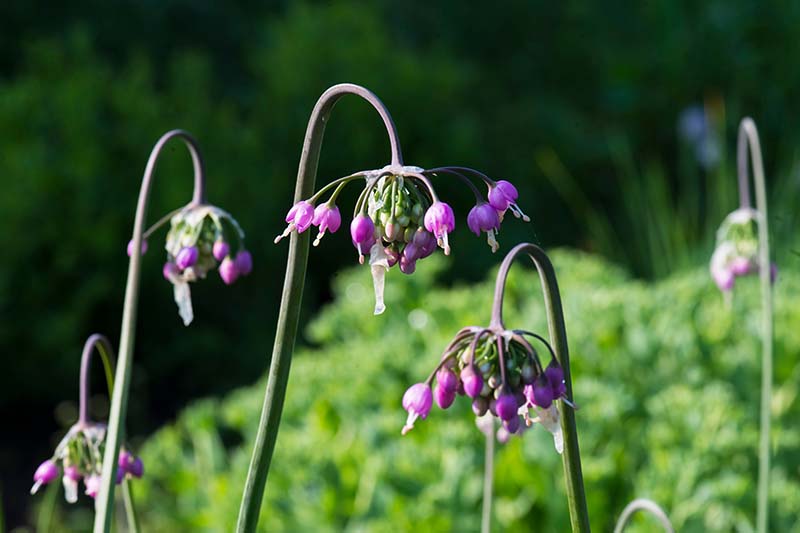
A member of the Amaryllis family, nodding onion grows to heights of 12 to 18 inches with a spread of three to six inches.
This species can be grown in full sun or light shade. Afternoon shade is particularly welcomed in hot climates.
Nodding onion adapts readily to dry to moderately moist conditions, grows best in sandy loam, and prefers an alkaline soil pH.
Like the black-eyed Susan, this species can tolerate juglone and is not attractive to deer.
Nodding onion can be put to good use in rock gardens, cottage gardens, or natural areas. Because of its smaller stature, it would be well-placed at the front of a planting.
For even more visual impact, grow nodding onion in groups of plants rather than planting single specimens.
Nodding onion will find good companions among butterflyweed, wild bergamot, black-eyed Susan, purple coneflower, common yarrow, gray goldenrod, and Jerusalem artichoke.

You can find packs of 200 nodding onion seeds available from Everwilde Farms via Amazon.
14. Purple Coneflower
Purple coneflower, a favorite of native plant enthusiasts, parades its large, showy flowers from summer until first frost.
Also known as Echinacea purpurea, purple coneflower is native to the eastern United States, from the East Coast west to Texas, Colorado, Nebraska, and the Great Lakes region.
Perennial in Zones 3-8, this species reaches heights of two to five feet tall, and has a spread of 18 to 24 inches.
Purple coneflower has lance- or oval-shaped green leaves. Its large flowers have purplish pink petals and large, cone-shaped, orange centers.

This species grows best in full sun, but it will also tolerate part shade.
Drought tolerant, purple coneflower has low to medium moisture requirements, and needs to be planted in soil that drains well. It can tolerate rocky, clay, and shallow soils.
To learn more about this plant’s needs, be sure to read our guide to growing coneflowers.
When it comes to wildlife, birds appreciate the dried seed heads of purple coneflower, but deer tend to leave it alone.
Purple coneflower is also well known for its medicinal qualities, and is one of the species used to craft echinacea supplements.
In the landscape, purple coneflower can be used as a specimen plant, and it also works wonderfully in borders and beds.
Good companions for purple coneflower include black-eyed Susan, butterflyweed, common yarrow, gray goldenrod, New England aster, nodding onion, wild bergamot, and Jerusalem artichoke.
Purple coneflower seeds are available from Botanical Interests in 400 milligram packets.
15. Wild Bergamot
Our final selection is pure pleasure in a plant. Wild bergamot is undoubtedly a delight for the eyes, but its fragrant flowers and foliage make it a joy for the nose as well.
There are many species of bergamot or “bee balm,” as it’s also called, but Monarda fistulosa is one that has an extremely wide native range, including most of southern Canada.
In the US, its range extends from the East Coast to the Rockies, or depending on who you ask, most of the western states as well.
Wild bergamot is a hardy perennial in Zones 4 to 8, and it is a member of the mint family. It’s also called “Oswego tea” or “horsemint,” though this latter name is also used for other members of the mint family.
Wild bergamot has square stems, and grayish-green leaves that are arranged in opposite pairs. Its flowers bloom from summer to fall, growing in globular clusters that look like pom-poms and are pink to lilac in color.

This species grows to be three to four feet tall and 18 to 24 inches wide.
It thrives in full sun to part shade, likes dry to medium soil moisture, and is somewhat drought tolerant. It’s adaptable to many soil types but requires good drainage.
For tips on cultivating this and other types of monarda, as well as information about the use of monarda as a medicinal plant, check out our bee balm growing guide.
As its common name “bee balm” suggests, this species attracts bees, but also butterflies, and is a larval host for the raspberry pyrausta butterfly (Pyrausta signatalis).
Hummingbirds are also frequent visitors, feeding from its tube-shaped individual flowers.
In the landscape, you might use this native in an herb garden or perennial border.
Wild bergamot will find good companions among black-eyed Susan, butterflyweed, common yarrow, gray goldenrod, Jerusalem artichoke, nodding onion, and purple coneflower.
Wild bergamot is available for purchase in 100-milligram seed packs from Botanical Interests.
Turn on the Wildflower Power
Now that you have a short list of gorgeous options to choose from, planting native wildflowers at home should be even easier.
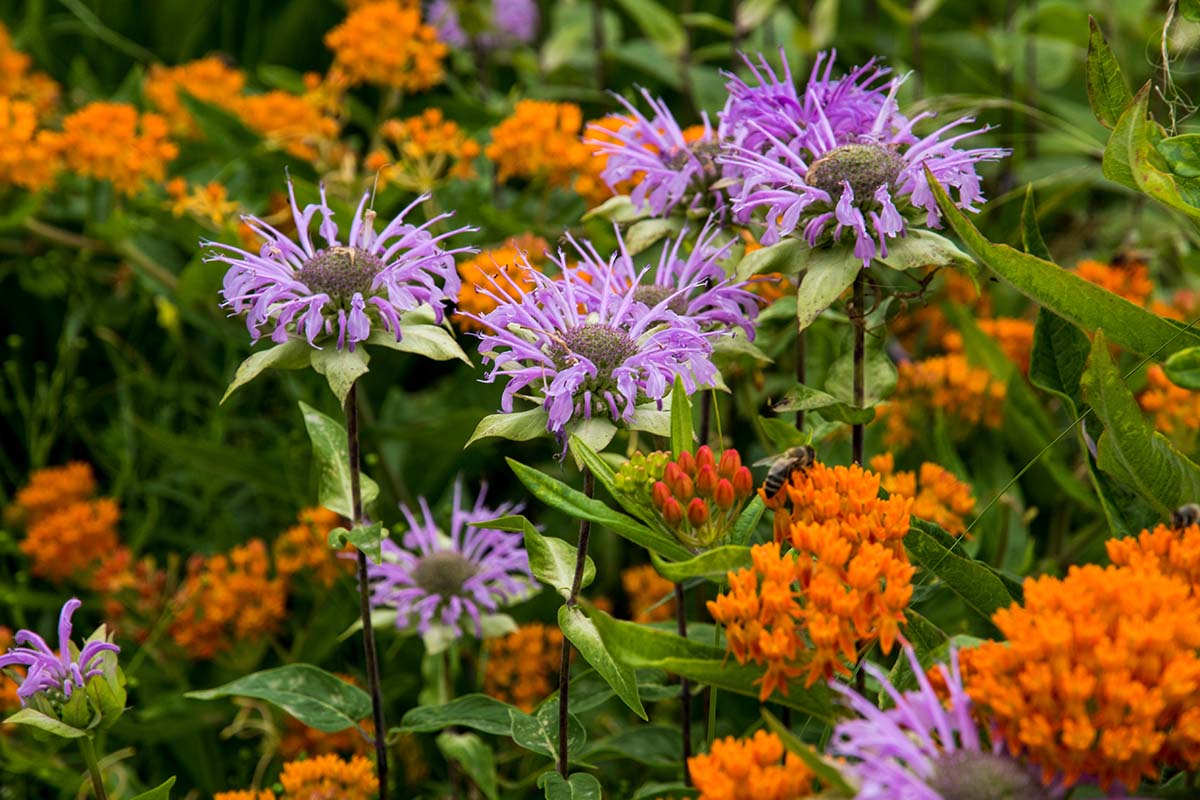
And if you want some tips on how to bring these plants together, make sure to read our article on growing native wildflowers in the landscape for lots of tips on how to really let these plants shine.
Do you have any other favorite native wildflowers? Let us know in the comments section below, and feel free to show off your own native plantings with a photo or two!
Want to learn about a few more wildflowers that are native to North America? Check out these articles next:
